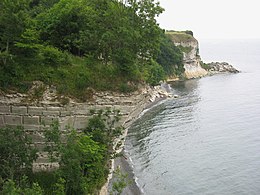Zealand
This article includes a list of general references, but it lacks sufficient corresponding inline citations. (November 2018) |
Native name: Sjælland | |
|---|---|
 The Cliffs of Stevns south of Copenhagen | |
 | |
| Geography | |
| Location | Danish straits |
| Coordinates | 55°30′N 11°45′E / 55.500°N 11.750°E |
| Area | 7,031 km2 (2,715 sq mi) |
| Highest elevation | 122.9 m (403.2 ft) |
| Highest point | Kobanke |
| Administration | |
| Region | Capital Region of Denmark, Region Zealand |
| Largest settlement | Copenhagen (pop. 1,627,705 (urban)[1]) |
| Demographics | |
| Demonym | Zealander |
| Population | 2,319,705 |
| Pop. density | 327.41/km2 (847.99/sq mi) |
Zealand (Template:Lang-da, pronounced [ˈɕɛˌlænˀ], Template:Lang-sv), at 7,031 km2, is the largest and most populous island in Denmark proper (thus excluding Greenland and Disko Island, which are larger). Zealand has a population of 2,319,705 (as of 1 January 2020).[2]
It is the 13th-largest island in Europe by area and the 4th most populous. It is connected to Funen by the Great Belt Fixed Link, to Lolland, Falster (and Germany from 2028) by the Storstrøm Bridge and the Farø Bridges. Zealand is also linked to Amager by several bridges. Zealand is linked indirectly, through intervening islands by a series of bridges and tunnels, to southern Sweden.
Copenhagen, the capital of Denmark, with a population between 1.3 and 1.4 million people in 2020, is located partly on the eastern shore of Zealand and partly on the island of Amager. Other cities on Zealand include Roskilde, Hillerød, Næstved and Helsingør.
Despite their identical names in English, the island is not connected historically to the Pacific nation of New Zealand, which is named after the Dutch province of Zeeland.
Etymology
The exact origin of the Danish name "Sjælland" is controversial. Sjæl in Danish today means "soul", but based on older records one can exclude this interpretation. Even a derivation derived from siô / sæ (meaning "sea") corresponding closely to the English name is today largely rejected – but it could be speculated that the English came up with their own separate name prior to the start of Danish research on the name's origin, and may have caused people thinking Sjælland means Zealand. The prevailing view today is: The Old Danish form "Siâland" comes from a composition of the word *selha- with the ending *wundia-. The latter means "indicates, resembles". The word *selha- can have two different meanings: it can mean on the one hand "seal" (in modern Danish sæl) and on the other hand mean "deep bay, fjord". Since the main settlement on Zealand was previously Roskilde, which is only accessible by sea through the narrow Roskilde Fjord (branched from the Ise Fjord), it is usually assumed that the sailors named the island after this.[3]
Mythological origins

In Norse mythology as told in the Gylfaginning, the island was created by the goddess Gefjun after she tricked Gylfi, the king of Sweden. She removed a piece of land and transported it to Denmark, which became Zealand. The vacant area was filled with water and became Mälaren.[4] However, since modern maps show a similarity between Zealand and the Swedish lake Vänern, it is sometimes identified as the hole left by Gefjun. Gefjun is queen of King Skjöldr, eponymous anchestor of the Scyldings, related to the etymological debate.
Geography

Zealand is the most populous Danish island. It is irregularly shaped, and is north of the islands of Lolland, Falster, and Møn. The small island of Amager lies immediately east.
Copenhagen is mostly on Zealand but extends across northern Amager. A number of bridges and the Copenhagen Metro connect Zealand to Amager, which is connected to Scania in Sweden by the Øresund Bridge via the artificial island of Peberholm. Zealand is joined in the west to Funen, by the Great Belt Fixed Link, and Funen is connected by bridges to the country's mainland, Jutland.
On June 5, 2007, the regional subsidiary of national broadcaster DR reported that Kobanke in the southeast near the town Rønnede in Faxe Municipality, with a height of 122.9 metres (403 ft), was the highest natural point on Zealand. Gyldenløveshøj, south of the city Roskilde, has a height of 126 metres (413 ft), but that is due to a man-made hill from the 17th century and its highest natural point is only 121.3 metres (398 ft).
Zealand gives its name to the Selandian era of the Paleocene.
Cities and towns
Urban areas with 10,000+ inhabitants:
See also
References
- ^ "StatBank Denmark - data and statistics". Statistics Denmark. Retrieved 7 November 2018.
- ^ BEF4: Population 1 January by Islands, Statistics Denmark
- ^ Katlev, Jan (4 August 2009). "Sjælland …". www.sprogmuseet.dk (in Danish). Danish Language Museum. Retrieved 29 November 2017.
- ^ Den Store Danske Encyklopædi, article Gefion
